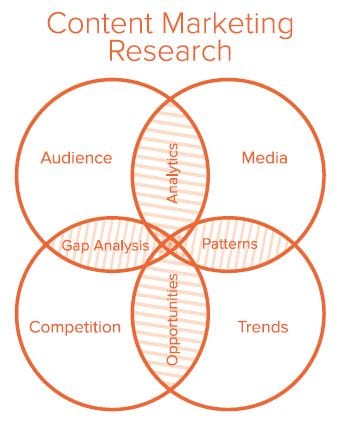How do you know your content is answering the pertinent questions your audience is asking? Do you know who the influential people and media outlets are in your space? Are you paying attention to product or service trends in your industry? How does your content marketing game stack up against that of your competitors?
All these questions are essential to ensuring your content gains traction, drives traffic and generates leads, yet they only scratch the surface of your big picture content marketing strategy.
The foundation of that strategy can be built through research assessments that analyze your audience, media outlets, trends and competitors, as shown in the diagram below.

Together, these assessments can be covered by 19 unique research tactics that will allow you to piece together a comprehensive strategy for your content marketing initiatives.
Audience Research Tactics
- Keyword research: Identifying the target keywords and related search terms used by your audience is critical for understanding how customers research products and services.
- User-generated content analysis: Researching forums and relevant social media platforms will provide a better understanding of your prospects’ pain points, the terminology they use and their preferred forms of content.
- Customer interviews: Hearing directly from customers in a more personalized, non-digital setting will provide greater context and understanding of their pain points.
- Expert interviews: Industry experts will have a forward-facing perspective on where the market is heading, and their opinions will allow you to better understand the relevant conversations happening in your space.
- Web analytics assessment: Diving into your web analytics will help you understand who your target demographic is, how they interact with your website, how to leverage your current content, how to track appropriate behaviors and how to optimize your website for conversions.
Trends Research Tactics
- Response analysis: By diving into audience conversations, you can determine the nature of content that drives them to certain behaviors, such as call-to-action language or special offers.
- Angle identification: Identifying the forms, voices, popular social media outlets and dynamic features that define compelling content will allow you to take your content to the next level by motivating readers to engage and share.
- Topic identification: Tracking and understanding long-tail keyword searches will allow you to identify specific topical pain points for your customers.
- Compelling questions identification: All prior research tactics will eventually give way to identifying compelling questions, or the primary questions that your content should focus on answering.
- Resources cited: Understanding how research is shared in your space, what the most reliable sources are, and who the authoritative figures are will provide general inspiration for your content marketing strategy.
- Quoted experts identification: Quotes from experts, industry influencers and internal members of your organization will help you better understand the ecosystem of engagement between businesses and consumers in your space, thus adding credibility to your content.
Media Research Tactics
- Industry publications analysis: Creating a database of popular and relevant industry publications is crucial for building your promotion strategy.
- Social influencer & expert analysis: Utilizing social networks, groups and lists will allow you to aggregate data and identify the most significant social influencers.
- Social engagement analysis: Knowing what’s trending on social media in your space will help you shape your creation strategy, and content analysis tools can measure engagement across social platforms to expose the most popular content.
Competitive Research Tactics
- Competitive content inventory: Building an inventory of your competitors’ content will provide you with an overview of the key pages, assets and resources you’ll be going up against.
- Competitive sentiment analysis: Taking a qualitative inventory of format, tone, emotion and readership level of your competitors’ content will expose opportunities for your own.
- Keyword gap analysis: An analysis of the primary keywords your brand is targeting, compared to those of your competitors, will allow you to locate content gaps and keyword opportunities.
- Site architecture & navigation audit: Assessing your competitors’ site architectures and navigation flows from SEO and UX perspectives can provide inspiration and clarity for creating the ideal customer experience on your own website.
- Local SEO evaluation: Local SEO audits allow you to narrow in on your product and service conversion opportunities while identifying variations between competitors.
From ideation and production to promotion and measurement, it’s crucial to develop and implement an overarching strategy that guides your content marketing efforts. By truly understanding the needs of your audience, the influential media channels, trending topics and your competitive landscape, you’ll be better suited to create and promote content that drives meaningful returns for your organization.
For more details on the 19 tactics listed above, or to see Relevance’s recommended tools for executing those tactics, check out new Quick Guide for Content Marketing Research. A concise and printable 10-page guide, this is a great tool for content marketers to keep at their desks.